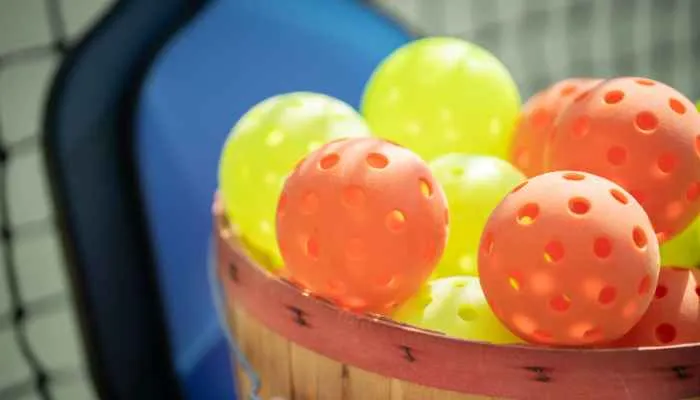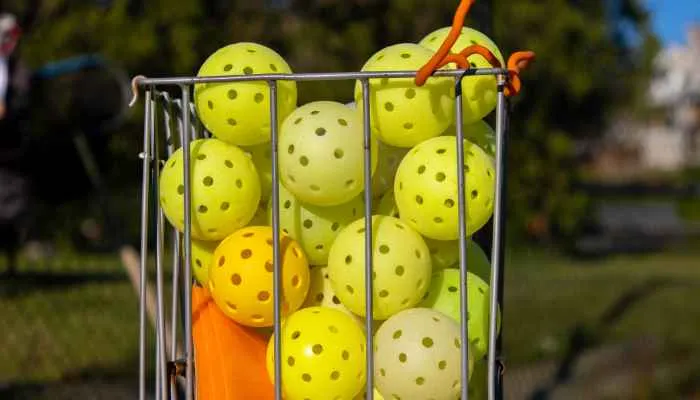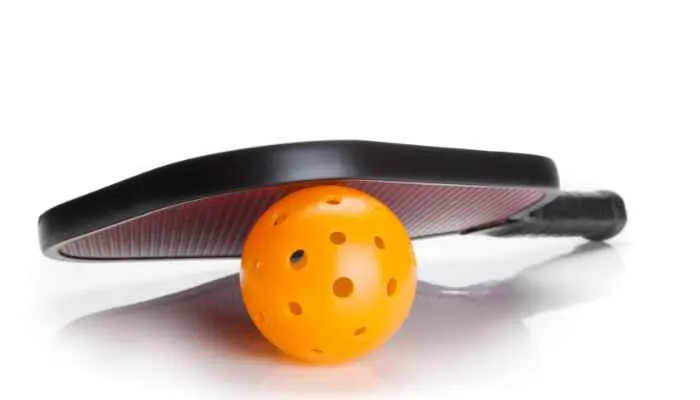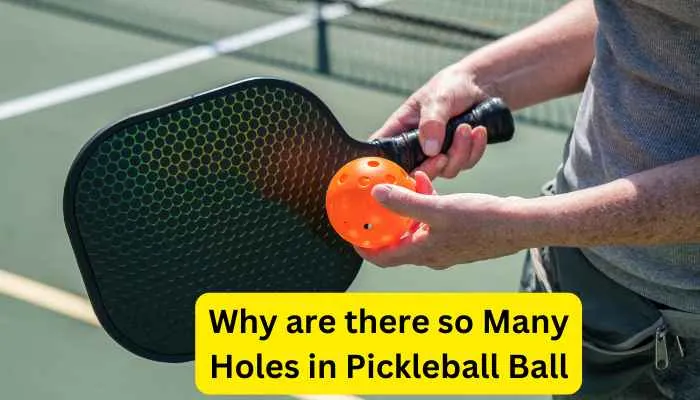Discover the science and strategy behind the many holes in pickleball balls. Explore how these holes enhance aerodynamics, spin, and player experience, shaping the unique sport we know today. Delve into the reasons behind this design choice and its impact on the game.
Pickleball, a rapidly growing paddle sport, has captured the hearts of many enthusiasts worldwide. Pickleball is unique because of its multiple holes, which sometimes raises the question, “Why are there so many holes in pickleball?” This essay will examine the design logic behind these holes and their significance in sports. Whether you’re a seasoned pickleball player or a curious beginner, let’s unravel the mysteries behind the design and functionality of these distinctive holes.
Table of Contents
Why are there so many holes in pickleball balls
The presence of numerous holes characterizes the design of the pickleball’s paddle surface. These holes serve several critical purposes, contributing to the gameplay, aerodynamics, and overall sports experience. Let’s explore the main reasons behind the prevalence of holes in pickleball.
- Las Vegas Night Owls and Brooklyn Aces Advance to Challenger Title
- 5s survive against Drive in Dream Breaker
- Mastering the Pickleball Court: Footwork Drills to Elevate Your Game
- The Small-Town Kid Who Became a Pickleball Superstar! Dylan Frazier’s Inspiring Story
- Amazon Prime Day Pickleball Deals 2024: Take up to 50% Off on Paddles
The Purpose of Holes in Pickleball Balls
The holes in pickleball balls serve several critical purposes that contribute to the game’s dynamics and player experience:

Aerodynamics and Flight
The holes significantly affect the aerodynamics of the ball during play. The unique hole pattern minimizes air resistance, allowing the ball to travel smoothly through the air. This feature enhances accuracy and control for players, making each shot more predictable.
Reduced Impact and Bounce
The presence of holes reduces the ball’s weight, resulting in a gentler impact when the ball makes contact with the paddle or the court surface. This characteristic prevents excessive bounce, enabling longer rallies and strategic gameplay.
Material Considerations
Manufacturers commonly produce pickleball balls from lightweight and durable materials, such as high-quality plastics. The holes in the ball help balance sturdiness and playability, ensuring the ball can withstand the rigors of competitive play while maintaining its unique flight characteristics.
Manufacturing Efficiency
The hole pattern plays a role in the manufacturing process as well. Mold injection, used to create these balls, is more efficient with a perforated design. This manufacturing advantage contributes to the widespread availability of pickleball balls.
The Role of Holes in Spin
Spin is integral to pickleball strategy, allowing players to add curves and control to their shots. The holes on the ball’s surface facilitate the creation and manipulation of spin. When the ball interacts with the paddle, air flows through the holes, creating a pressure differential that influences the ball’s trajectory.
Number of Holes in Indoor and Outdoor Pickleball balls
Pickleballs for playing indoors and outdoors have a different number of holes. Indoor pickleballs have 26 larger holes, while outdoor ones have 40 smaller holes. The number of holes makes the ball weigh differently and affects how it moves through the air and how fast it goes.
Ultimately, the number of holes on a pickleball is a big deal. Whether you like the slower vibe of indoor matches or the faster pace of outdoor games, knowing the differences can help you choose the right pickleball for your kind of play.
Read More: How Many Holes In An Outdoor Pickleball: Unraveling The Mystery
Hole diameter in outdoor and indoor pickleball balls
Indoor Pickleball Hole Diameter
Indoor pickleballs have bigger holes than outdoor ones. The holes are around 0.43 inches wide on average. These bigger holes slow the game, which works well for indoor matches. The slower speed helps players guide the ball better, placing shots just where they intend. But, because of the bigger holes, the wind can affect these indoor pickleballs more. The holes catch more air, making it tricky to control the ball when it’s windy.
Outdoor Pickleball Hole Diameter
Outdoor pickleballs have tinier holes than indoor ones, measuring about 0.282 inches across on average. These smaller holes make the game speedier, which suits outdoor matches well. The faster game needs players to be quick and good at hand-eye coordination.
With smaller holes, outdoor pickleballs are also less bothered by the wind. Since the holes catch less air, controlling the ball when windy is simpler. But, because of the smaller holes, outdoor pickleballs don’t grip the paddle as much. This makes it harder to put spin on the ball.

The Impact of Hole Diameter on Gameplay
The holes’ size on pickleballs changes how the game goes. Bigger holes on indoor pickleballs slow things down and give more control. Smaller holes on outdoor pickleballs speed things up and make it more challenging.
People who like a slower, more controlled game might go for indoor pickleballs. Those who enjoy a faster, more challenging game might like outdoor ones. Remember that hole size isn’t the sole factor in the game. The ball’s weight, hardness, and surface area all impact how it feels and performs.
Read More: How Long Does A Pickleball Ball Last? Tips To Extend Its Lifespan
Weight and Hardness
Pickleballs have two critical things: how heavy and hard they feel. Indoor and outdoor pickleballs are different when it comes to weight and hardness. This affects how they bounce, feel when you hit them, and how they do in different situations.
Weight
Outdoor pickleballs tend to possess greater weight than their indoor counterparts, although this variance in weight is typically minimal, often less than 1%. Despite its seemingly small impact, this slight distinction significantly influences the ball’s bouncing behavior and the tactile sensation upon impact. A heftier ball demonstrates enhanced stability in windy conditions, albeit it might pose a more significant challenge.
Conversely, a lighter ball offers easier maneuverability but is more susceptible to being influenced by factors like wind. Opting for the appropriate weight hinges on skill level, playing style, and the specific environment. Experimenting with different weights is advisable to ascertain the most suitable fit for newcomers. If confronted with windy outdoor conditions, a heavier ball performs better. On the other hand, indoor settings favor the manageability of a lighter ball.
Hardness
Outdoor pickleballs are usually more challenging than indoor ones, affecting how they bounce and feel when you hit them. A harder ball might bounce higher and faster, but it could be harder to control. A softer ball, on the other hand, might be easier to control but might bounce lower and slower. Based on your skill level, how and where you play.
You should experiment with different pickleball balls to see what works best if you’re new. A harder ball might be better if you’re on a solid court. A softer ball might be easier if you’re on a soft court. Ultimately, your game’s best weight and hardness depend on many things, like your skill, style, and where you play. Choose a ball that feels right and lets you play your best. So, try different balls until you find your perfect match!

Durability of the pickleball balls
Durability is an important consideration when it comes to pickleballs. The durability of a pickleball can have an impact on gaming and overall pleasure. Let’s look closer at the durability differences between indoor and outdoor pickleballs and the elements that influence their longevity.
Indoor Pickleballs
Indoor pickleballs usually last longer than outdoor ones. Softer plastics are frequently used to make these balls, allowing them to withstand hits from paddles and courts without breaking. But even indoor pickleballs wear out eventually.
The soft plastic can change shape over time, which messes with how the ball moves. How much you use them, what kind of court you play on, and how hot or humid it is can all affect how long indoor pickleballs last. Store them somewhere cool and dry, away from weird shapes or colors, to keep them in good condition.
Outdoor Pickleballs
Outdoor pickleballs are much more long-lasting compared to indoor ones. They’re often made from more rigid plastic, so they can take hits from paddles and courts without breaking. The holes on outdoor pickleballs are shorter and packed closer together, which helps them stay in shape longer.
Still, outdoor pickleballs need to be invincible. Stuff like hot or cold weather, humidity, and sun rays can affect how long they last. Playing on a rough surface or in windy conditions might also cause them to wear out faster. Keep outdoor pickleballs in a cool, dry spot and out of the sun for as long as possible.
Choosing the Right Pickleball balls
Picking the right pickleball ensures you play comfortably and your gear lasts. When choosing a pickleball, consider the court surface, where you’re playing, and what you like. For indoor games, go for a softer indoor pickleball. If you’re outdoors, a harder outdoor one is better. It’s wise to spend on good pickleballs from brands people trust.
Pro players often use Dura balls because they’re tough and work well every time. While cheap pickleballs offer a good deal, they are usually made of subpar materials that negatively affect their durability and performance over time. When you choose the right pickleball and look after it, you’ll have more fun, and your gear will stick around. So, take your time picking the perfect pickleball!
Conclusion
In the world of pickleball, picking the proper ball is super important. We’ve talked about how indoor and outdoor pickleballs have lots of differences. The holes, weight, hardness, and even how challenging they are – everything matters for how you play. But can you use indoor pickleballs outside or outdoor ones inside? Technically, you could, but it’s not a great idea. The wrong ball can mess up your game big time. Nobody wants a flatball in the middle of a big match!
To wrap it up, knowing the differences between indoor and outdoor why so many holes in pickleball balls is a big deal for being great at the game. Those holes aren’t just for show – they matter. Picking the right ball can make you a much better player. And don’t forget about things like wind and noise! So, next time you’re out on the pickleball court, ensure you’ve got the right ball for your game. Get ready to play like a real champ!
Are there regulations regarding the number of holes on a pickleball ball?
Yes, official pickleball regulations specify the maximum and minimum number of holes a ball can have to ensure consistent gameplay.
Do the holes in pickleball balls affect their durability?
While the holes are strategically designed not to compromise durability, intense gameplay can still wear down the ball over time.
Can the hole pattern on a pickleball ball affect the spin generated?
The hole pattern is crucial in creating air pressure differentials that influence spin.
Are there variations in ball design for indoor and outdoor pickleball?
Yes, outdoor balls often have larger holes to counteract the effects of wind and make them more suitable for outdoor play.
Do professional pickleball players have preferences for specific hole patterns?
Some players might prefer certain hole patterns based on their play style, but most adapt to the standard ball design.

